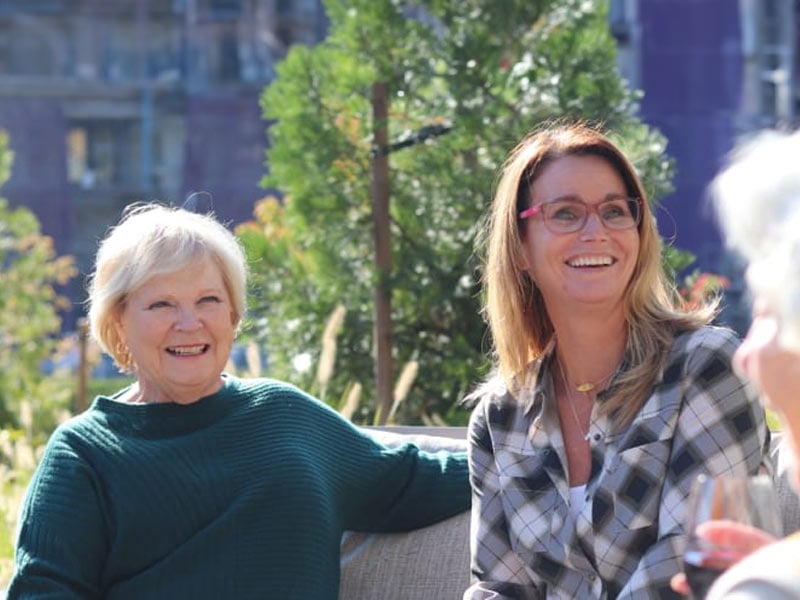A very common question we hear at The Springs Living is: How much does it cost? While many factors go into choosing the right community, the bottom line typically begins or ends with the same question: Can I afford this? In this two-part series, we dive into the monetary and emotional costs of senior living, and how to navigate a good decision for you.
Someone turning 65 today has almost a 70% chance of needing some type of long-term care, and 20% of people will need it for longer than five years, according to LongTermCare.gov. The average cost of senior care varies by state, by community, and by needs. This is why you don’t see an easily accessible monthly cost plastered on most websites or brochures. The good news is there are steps you can take to plan for your future – whether a senior community is needed now, next month or in the next decade.
“There are many ways to cover the costs of long-term care, including savings, investments, assets, long-term care insurance, state LTC (long term care) Partnership programs, the Federal LTC Insurance Program and tax advantages,” explains Eric Christensen, Regional Director of Operations for The Springs Living. “In probably 99% of the situations I encounter, seniors underestimate their ability to afford an amenity-rich environment.” Christensen explains that income and assets are typically more plentiful than most people realize. “It often comes down to mindset. The generation in senior living today does not want to spend their money on themselves, but they deserve to have something nice, and their adult children want them to do it.” Christensen emphasizes that open and honest conversations are crucial for families to have early and often.
Christensen, who has worked in senior care since 2005, has heard multiple times from the adult children that they are spending more of their time on elder care than on childcare. “Our seniors underestimate the amount of time their children are spending to support their parents. It’s really important to look at all sides of the conversation. Remove the burden of having to provide services, and you become the child again. There is an emotional and financial toll that being a caretaker can bring upon an adult child, and it’s important to recognize this as you’re making these decisions. Typically, it’s the adult child who pays for the painters, the carpet cleaners, or an overnight nurse. They’re also there on the weekends and evenings, sacrificing time with their own children, to do the laundry, make meals, or drive their parent to appointments. Many adult children pay quite a bit to make sure mom and dad are comfortable and safe in their homes, and it’s just not sustainable.”
Care Conversations, an initiative led by the American Health Care Association, the National Center for Assisted Living and America's Skilled Nursing Caregivers, offer a helpful list of private and public payment sources in greater detail. Christensen recommends checking out these types of sources and also speaking with someone at The Springs Living to help you understand your finances in greater detail. Ideally, financial planning for long-term care should occur long before the need arises.
This is one of many reasons why pricing is not easy to find when you’re researching senior living communities without first sitting down with a representative.
“We believe honesty is the best policy,” says Lauren Kippen, Executive Director of The Springs Living in Butte and Billings, Montana. “One of the things I never want to do is a bait and switch presentation. We are honest right from the start regarding the cost of assisted living. We work through what we call ‘the cost of living worksheet,’ and this better illustrates for everyone involved how much you currently spend on your standard of living, and puts the community living into perspective.”
Kippen says anyone can calculate their current cost of living, even without sitting with an expert (although this is a free service The Springs Living provides to prospective families). Simply write out your expenses such as mortgage, food, utility bills and home insurance. “Remember to include home repairs, upkeep and yard work. All of these things are included in the cost of living here at The Springs Living, so it’s very important to write out all of your costs to get a clear picture for comparison.”
Kippen says the reason the price tag is not out in the open is because every situation is unique. “We try to understand what you are looking for in a community. Perhaps you’re looking for more social engagement, or you’re having difficulty doing laundry or getting up and down steps, or cleaning up after dinner. There’s so much more that goes on behind the scenes and that’s why we treat each case as an individual process.” Kippen acknowledges that the money talk is hard, but it’s important to have. “We don’t hurry the process — everyone gets the attention they desire. You can take as much time as you need and ask as many questions as you have. We do get people who say they don’t want to move in because they want to give the money to their kids, but the kids want them to move in! The grown children want mom and dad to be taken care of, they want that peace of mind more than they want their parents' money,” she says. “I’m proud of what we do, at the end of the day, we’re providing more than a room for rent. We’re providing services and care around the clock, and there’s no price tag for that.”
Financially speaking, planning is the most important part of paying for senior living. Start by writing out your current expenses, including the costs adult children may be incurring. Once you have a detailed financial picture, you’re ready to compare prices of senior communities with more of a direct comparison to your actual cost of living. Many people make the mistake of only looking at mortgage or bills as their comparison to what they will spend monthly on senior living. Once you add in all of the ancillary costs, you can better plan and make decisions based on your current level of living.
In the second part of our two-part series on the cost of senior living, we’ll take a deeper look into the emotional cost comparison of senior living versus staying at home.












